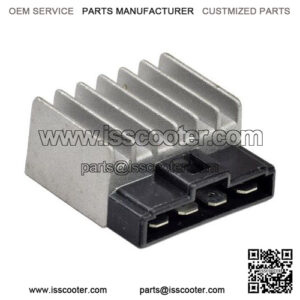Are you concerned that your regulator rectifier could be on the fritz? If you suspect that this vital component of your bike could be running on its last leg, keep reading for the top symptoms of failure and some practical solutions to resolve the issue.
You won’t want to miss these helpful tips and easy step-by-step guide to checking your regulator rectifier’s voltage.
Understanding How the Regulator Rectifier Works
If you want to learn how to know if regulator rectifier is bad, it’s crucial to understand how this component of your bike works in the first place. Modern bikes have batteries featuring electrical charging circuitry. A regulator rectifier is a standard component of this circuitry.
The name of this part is appropriate, as a regulator rectifier regulates and rectifies voltage. Your bike’s alternator stator coil produces AC voltage. Generally, motorcycles feature a three-component system containing three wires that link the stator to the regulator rectifier. Some bikes have single-phase designs because they cost less to manufacture, in which case there would be two wires rather than three.
In any case, the regulator rectifier converts the AC power into DC power, then regulates the DC power to ensure that the power doesn’t go over around 14.5 volts. At this point, the DC voltage routes to the battery of the bike.
Common Causes of Failure
There is a wide range of possible reasons your motorcycle’s regulator rectifier could fail. A faulty regulator rectifier could not only affect things like motorcycle values but will impact the bike’s performance on the road. One of the primary causes of failure is heat. Different motorcycle manufacturers install the regulator rectifier in different locations of the bike, with some placing the part near the radiator or other sections of the bike that impede airflow.
Depending on where your bike’s regulator rectifier is located, the part can overheat. When it overheats, the component could fail fast.
Other common causes for regulator rectifier failure involve the battery. To have voltage, the battery needs to have a reliable ground connection. If the link is bad and the voltage is faulty, this can cause the regulator rectifier to run hotter than usual. Things like poor grounding, a loose or weak battery, and a worn battery connection can all lead to regulator rectifier failure.
Key Signs to Look For
So, how to know if regulator rectifier is bad? In general, there are two primary ways that the regulator rectifier can fail. First, the diode can burnout and cause the battery to drain. You won’t have any trouble diagnosing the faulty regulator rectifier if the battery is the cause. You’ll note signs right away like poor starts, fluctuating meter readings, and dimmed headlights.
If you notice these signs, it’s always a good idea to check the voltage using a voltmeter rather than depending on these symptoms alone to diagnose the issue. If the voltage goes below
around 13 volts, the bike will start to drain the battery. When this happens, it’s only a matter of time before the engine stops completely.
The other way that your regulator rectifier could fail is when the shunt regulator burns out. If the regulator rectifier can’t moderate the voltage levels, the battery will overcharge.
You can also use a voltmeter to diagnose overcharge. If you get readings over 17 volts, this generally means that the regulator rectifier is failing to convert the excess power. All this additional voltage could make the headlights increasingly bright before blowing out.
It is essential to mention that you should always examine the condition of the components in your bike’s electrical circuitry. The step is integral when determining if the regulator rectifier is experiencing failure. Issues with any of the circuitry parts could cause failure. If your regulator rectifier has already died, take a look at the internal connections. Sometimes, a manufacturing defect could also lead to failure.
How to Test the Regulator Rectifier for Failure
In most motorcycles, the regulator and rectifier are located together in the same unit, but other older models have them installed separately. Here’s what you need to do to test your rectifier for failure:
- Start by disconnecting the wires in your bike and switching the multimeter to diode function.
- Take a look at the positive diode by inserting the positive lead into the bike’s positive diode.
- Next, connect your negative lead to the stator inputs. You shouldn’t see any readings on the meter yet.
- Assuming everything looks good at this point, connect the positive diode to the negative lead before connecting the positive lead to all stator inputs. At this point, the meter should show you something, but the specific numbers are irrelevant.
- Repeat for the negative diode by connecting the positive lead to the negative diode and connecting the stator inputs and negative lead.
- The meter shouldn’t show any reads when you connect the positive lead and stator inputs.
- To check the regulator, connect the meter leads to the bike’s battery as it’s running. The reading should not be higher than 14.5 volts or lower than 13.5 volts. If the reading is higher, this means the battery is overcharged and you may need to replace the regulator rectifier.
Replacing the regulator rectifier could cost you anywhere from $20 to upwards of $100. Considering the prices of motorcycles, knowing how to recognize the signs of a failing regulator rectifier could save you plenty of time, trouble, and expense. If you catch the issue early on, you could replace the component for a relatively affordable price and potentially avoid full battery failure down the road.
It doesn’t matter whether you’re interested in purchasing a new motorcycle or prefer used motorcycles values. Conducting a vehicle search could provide you valuable insight into any bike you’re considering and help you avoid potentially faulty systems. Plus, don’t forget to use a motorcycle loan calculator when you search for your next bike to help find the best deal for your budgetary needs.
About Regulator Rectifier
“scooter regulator wiring”
“scooter regulator price”
“scooter regulator rectifier test”
“scooter regulator bad”
“chinese scooter regulator/rectifier”
“how to test scooter regulator”
“how to tell if scooter regulator is bad”

